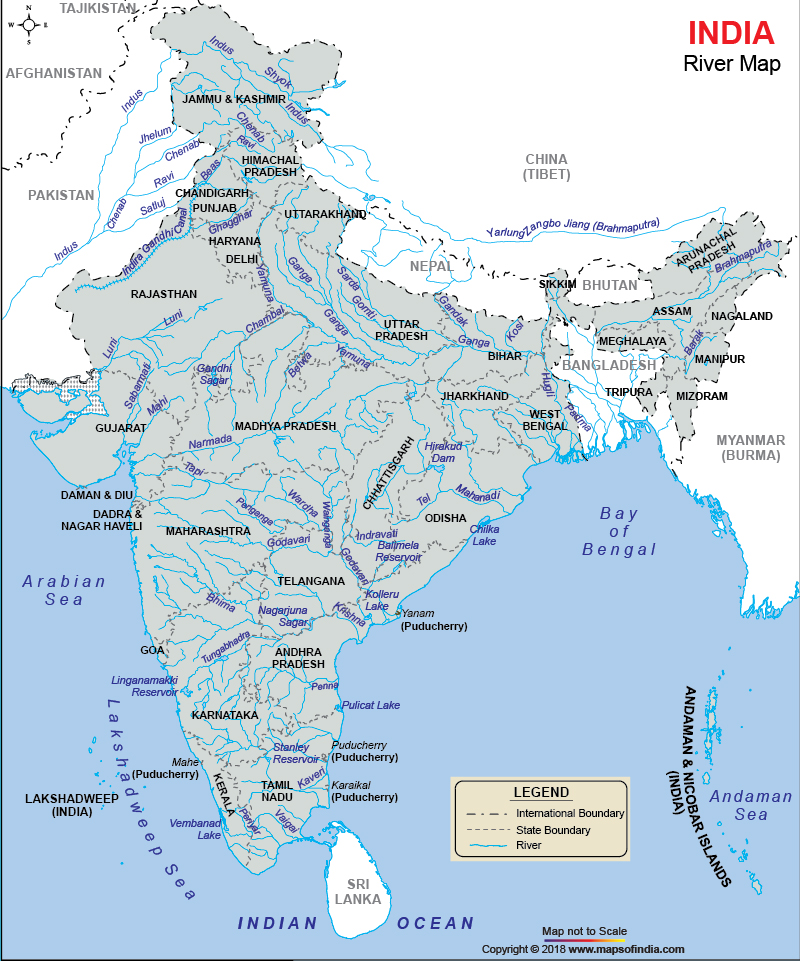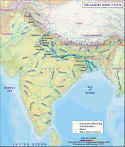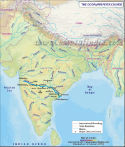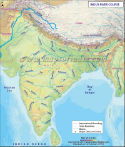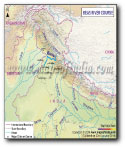All the major rivers of India originate from one of the three main sources:
- The Himalaya and the Karakoram ranges
- Sahyadri or Western Ghats in western India
- Vindhya and Satpura ranges and Chotanagpur plateau in central India
The largest river basin of India is the Ganga basin, which receives water from Himalayas in the north and the Vindhyas in the South. The Ganga, Yamuna, Ghagra, Gandak and Kosi are the main constituents of this basin.
The Brahmaputra has the greatest volume of water of all the rivers in India. It is the source of the Indus and the Satluj and flows through Arunachal Pradesh and Assam
The Mahanadi is an important river in the state of Orissa. This river flows slowly for 900 km and deposits more silt than any other river in the Indian subcontinent.
The Godavari River System has second longest course within India. The banks of this river have many pilgrimage sites like Nasik, Triyambak and Bhadrachalam.
The Krishna is the third longest river in India with a length of about 1300 km. It rises in the Western Ghats and flows east into the Bay of Bengal.
The source of the Kaveri is located in the Western Ghats. It has many tributaries including Shimsha, Hemavati River, Arkavathy, Kapila, Honnuhole, Lakshmana Tirtha, Kabini, Lokapavani, Bhavani, Noyyal and famous Amaravati. Kaveri is a major source of irrigation in Tamil Nadu.
The Narmada and the Tapti are the only major rivers that flow into the Arabian Sea. The total length of Narmada through the states of Madhya Pradesh, Maharashtra, and Gujarat amounts to 1312 km. The Tapti follows a parallel course to the south of the Narmada, flowing through the states of Maharashtra and Gujarat on its way into the Gulf of Khambhat.
The rivers of India play a significant role in the lives of the people of India. Indian river systems help us in a number of ways. They offer drinkable water, cheap conveyance, irrigation, help in producing electricity, and are the sources of income for a considerable number of inhabitants throughout India. On certain occasions, India is denoted as the "Land of Rivers". The large number of tributaries and close association of Indian society and tradition to the indigenous rivers are the bases for this depiction.
Rivers of India
An overview
Almost all the important Indian cities are situated on the banks of the rivers of India. Rivers of India also have a crucial role in Hindu mythology and are regarded sacred by all the followers of Hindu religion in India. There are nine important rivers of India and they are: The Ganges, Yamuna (a tributary of Ganges), Brahmaputra, Mahanadi, Narmada, Godavari, Tapi, Krishna, and Kaveri. Parts of the Indus River also flow over Indian soil.
Eight important rivers together with their various tributaries comprise the river system of India. Majority of the rivers discharge their waters into the Bay of Bengal; nevertheless, a number of the rivers whose itineraries take them across the western end of India and in the direction of the east of the state of Himachal Pradesh pour into the Arabian Sea. Northern portions of the Aravalli range, portions of Ladakh, and the barren areas of the Thar Desert have inland drainage.
- Chotanagpur plateau and Vindhya and Satpura ranges in central India
- The Himalaya and the Karakoram mountain ranges
- Western Ghats or Sahyadri in western India
Rivers running into the interiors of India include the following:
- Musi River at Hyderabad, India
- Ghaggar-Hakra River in Haryana, Rajasthan
- Samir River, India/Gujarat
br /> Rivers like the Ganges (with its tributaries Kameika, Yamuna, Chambal, Gomti), Brahmaputra, Godavari, Mahanadi, Kaveri, Krishna and their principal tributaries flow into the Bay of Bengal. The Indus, Tapti, and Narmada Rivers together with their key tributaries flow into the Arabian Sea. The Himalayan rivers are snow-fed and perennial rivers. The other rivers are either coastal rivers or they flow into the interiors of India.
Go to any place in India and you will be moved to see how much the rivers control the economy and indigenous cultures. Definitely, Indians have revered rivers as a shape of Mother Goddess from the prehistoric era.
Holiness of the Rivers of India
Rivers of India are regarded sacred. Indian rivers have plenty of spiritual importance. Respected, worshipped, and cared for, these rivers form an integral part of every Indian life. Nothing progresses in their absence. They are as special as the Indian temples for a devotee. You can visit some of these rivers to understand what they imply to a common Indian man.
Ganga or the Ganges
The Ganga and its tributaries such as Son, Yamuna, Budhi Khandak, Gandak, and Sabazpati have been omitted from the list, which originally creates the largest cultivable plains of northern and eastern India, named as the Gangetic plains. The principal river, the sacred Ganga is formed by the union of Andha and Alaknanda. Ganga originates from Gangotri glaciers (Gaumukh - 13,858 ft) in the Himalayan mountain range and gushes from Uttar Pradesh and Bihar, and then comes into West Bengal and Bangladesh. It finally finishes in the Bay of Bengal in Bangladesh, where the name of the river is Padma.
The Brahmaputra River System
The Brahmaputra starts off from the Mansarovar lake, which is also the place from where the Sutlej and the Indus have originated. It is somewhat longer than the Indus, however the greater portion of its itinerary is situated outside India. It runs to the east in China, adjacent to the Himalayas, known as Tsang-Po. When it arrives at Namcha Barwa (2900 m), it takes an about turn close to it and moves into India in Arunachal Pradesh and is named as Dihang.
The Indus River System
The source of Indus River is located in the northern sides of the Kailash mountain range close to Lake Mansarovar in Tibet. In spite of the fact that the maximum portion of the river's itinerary flows across bordering Pakistan, a part of the river flows across Indian soil, similar to portions of the itineraries of its five important tributaries mentioned below. The tributaries of Indus River played a key role behind the origination of the name " Punjab". The word "Punjab" has originated from the Persian words Punj ("five") and aab ("water"), therefore the blend of the words (Punjab) signifies "land of five waters" or "five waters". The tributaries of Indus River are as follows:
- Beas
- Chenab
- Jhelum
- Ravi
- Sutlej (Satluj)
The Narmada River System
The Narmada' or Nerbudda is a river situated in central India. It creates the conventional frontier between South India and North India. The overall length of the river is 1,289 km (801 miles). The Narmada, the Mahi, and the Tapti are the important rivers of peninsular India that flow from east to west. The source of Narmada is Amarkantak.
The Taapi River System
The Taapi is a river situated in central India. It is one of the important rivers of the Indian peninsula and is approximately 724 km long. It climbs in the eastern Satpura range of Southern Madhya Pradesh, prior to pouring into the Gulf of Cambay of the Arabian Sea in Gujarat.
The Godavari River System
Godavari is a river, which has the second biggest itinerary in India and is frequently named as the Dakshin (South) Ganga or the Vriddh (Old) Ganga. The length of the river is approximately 1,450 km (900 mi). It climbs at Trimbakeshwar, close to Mumbai (erstwhile Bombay) and Nasik in Maharashtra about 380 km away from the Arabian Sea, and pours into the Bay of Bengal. At Rajahmundry, 80 km from the seashore, the river is divided into two watercourses (Vasista which runs to Narsapur and Gautami which runs to other side pasarlapudi), therefore creating an extremely productive delta.
The Krishna River System
The Krishna is one of the biggest Rivers in India (approximately 1,300 km long). It starts off from Mahabaleswar, Maharashtra and joins the sea in the Bay of Bengal at Hamasaladeevi, Andhra Pradesh. The river runs across the states of Karnataka, Maharashtra, and Andhra Pradesh.
The Kaveri River System
The Kaveri (also known as Kavery or Cauvery) is one of the major rivers in India and is regarded as holy by the Hindus. It is a sacred river for the South Indians. The origin of the Kaveri River is known as Dakshin Kashi. There are two temples: Caveri temple at Talakaveri and God Shiva Temple known as Bhagandeshwar at Bhagamandala. The sources of the river are located in the Western Ghats mountain range of Karnataka, and from Karnataka across Tamil Nadu. The Kaveri pours into the Bay of Bengal.
The Mahanadi River System:
The delta of Mahanadi River in India is a significant drainage area, which drains big areas of the Indian subcontinent into the Bay of Bengal. The alluvial basin is extensive and comparatively plane with a winding river waterway that alters its itinerary.
The Mahanadi River runs steadily for 560 miles (900 km) and features a projected catchment basin of 51,000 sq miles (132,100 square km). The river sediments higher amount of silt as compared to any other Indian river.
Rivers flowing into Bay of Bengal
Given below is a list of rivers flowing into the Bay of Bengal:
(1) Subarnarekha
- (a) Kharkai
(3) Damodar
(4) Meghna River from India and Bangladesh
- (a) Titas River in Tripura
- (i)Haora River in Agartala.
(1)Brahmaputra River
- Burhidihing River, also named Noa Dihing in the beginning of its itinerary through Namdapha National Park
- Lohit River
- Disang
- Kameng River
- Bhogdoi
- Dikhou
- Dhansiri River
- Kakodonga
- Kapili
- Subanshiri
- Manas River
- Pagladiya
- Yamuna
- Sankosh
- Teesta River
- (a) Lachen River
- (b) Rangeet River
- (c) Lachung River
- Dharla River in Bangladesh
- (a) Jaldhaka in Sikkim
(1) Ganges River
- Hooghly River (distributary)
- (a) River Churni
- (b) Jalangi River
- (c) Ichamati River
- (d) Damodar River
- (i) Barakar River
- (e) Ajay River
- (f) Rupnarayan River
- (g) Tirap
- (h) Siang
- (i) Dwarakeswar River
- (j) Mayurakshi River
- (k) Mundeswari River
- Padma River (distributary)
- Meghna River (distributary)
- Kosi River
- Budhi Gandak
- Gandak at Patna
- Falgu River
- Son River
- (a) Koel River
- (b) Rihand River
- (c) Gopad River
- (i) Goini River
- (ii) Neur River
- (d) Banas River
- Yamuna River
- (a) Ban Ganga River
- (b) Betwa River
- (i) Halali River
- (ii) Dhasan River
- (iii) Kaliasote River
- (c) Sindh River
- (i) Pahuj River in Bhind District Madhya Pradesh
- (ii) Kwari River
- (d) Chambal River
- (i) Banas River
- Berach River
- Ahar River
- (ii) Parbati River (Madhya Pradesh)
- (iii) Kali Sindh River
- (iv) Shipra River in Ujjain
- (i) Banas River
- (e) Gambhir River
- (i) Parbati River (Rajasthan)
- Ghaghara River (Gogra) or Karnali River in Nepal
- Gomti River
- Ramganga River
- (a) Kho River
- (i) Surkho River
- (ii) Malini River
- (a) Kho River
- Mahakali River
- Mahananda River
- Alaknanda River
- Bhagirathi River
- Beson River
- Gangi River
- Bhainsai River
- Mangai River
- Karmanasha
- Tamsa River
West Bengal Coastal Rivers
- (a)Kangsabati River
- (i)Bhagirathi
- (ii)Hughli
- (b)Subarnarekha River
- (i)Kharkai River
- Brahmani River
- Mahanadi River
- South Koel River near Rourkela
- Baitarani River
- Devi River
- Sankh River
- Daya River
- Kusabhadra River
- Kadua River
- Bhargavi River
Godavari River Basin
Godavari River in the states Maharashtra and Andhra Pradesh,
- (a)Indravati River in Gadchiroli district of Maharashtra and also in Chhattisgarh state.
- (i) Bandiya River in Gadchiroli
- (b)Kolab River in Orissa State
Last Updated on : March 13, 2020
